Monte-Carlo-Based Estimation of the X-ray Energy Spectrum for CT Artifact Reduction
Abstract
1. Introduction
2. Materials and Methods
2.1. Monte Carlo Simulation
2.1.1. Calculation of X-ray Spectrum Inside the Flat Panel Detector
2.1.2. Calculation of the Emitted X-ray Spectrum
2.2. Maximum Likelihood Expectation Maximization Method (MLEM)
2.2.1. Theory and Mathematical Calculations
2.2.2. Experiments
2.2.3. Initial Guess
3. Results and Discussion
4. Conclusions
Author Contributions
Funding
Institutional Review Board Statement
Informed Consent Statement
Data Availability Statement
Acknowledgments
Conflicts of Interest
References
- Li, Y.; Garrett, J.; Chen, G.-H. Reduction of beam hardening artifacts in cone-beam CT imaging via SMART-RECON algorithm. In Medical Imaging 2016: Physics of Medical Imaging; International Society for Optics and Photonics: Bellingham, WA, USA, 2016; Volume 9783. [Google Scholar]
- Hao, W.; Vernekohl, D.; Zhu, J.; Wang, L.; Xing, L. A model-based scatter artifacts correction for cone beam CT. Med. Phys. 2016, 43, 1736–1753. [Google Scholar]
- Sisniega, A.; Abella, M.; Lage, E.; Desco, M.; Vaquero, J. Automatic Monte-Carlo based scatter correction for X-ray cone-beam CT using general purpose graphic processing units (gp-gpu): A feasibility study. In Proceedings of the 2011 IEEE Nuclear Science Symposium Conference Record, Valencia, Spain, 23–29 October 2011. [Google Scholar]
- Davidson, D.W.; Fröjdh, C.; O’Shea, V.; Nilsson, H.E.; Rahman, M. Limitations to flat-field correction methods when using an X-ray spectrum. Nucl. Instrum. Methods Phys. Res. Sect. A Accel. Spectrometers Detect. Assoc. Equip. 2003, 509, 146–150. [Google Scholar] [CrossRef]
- Primak, A.N.; Ramirez Giraldo, J.C.; Liu, X.; Yu, L.; McCollough, C.H. Improved dual-energy material discrimination for dual-source CT by means of additional spectral filtration. Med. Phys. 2009, 36, 1359–1369. [Google Scholar] [CrossRef]
- Six, N.; De Beenhouwer, J.; Sijbers, J. poly-DART: A discrete algebraic reconstruction technique for polychromatic X-ray CT. Opt. Express 2019, 27, 33670–33682. [Google Scholar] [CrossRef] [PubMed]
- Bismark, R.N.; Frysch, R.; Abdurahman, S.; Beuing, O.; Blessing, M.; Rose, G. Reduction of beam hardening artifacts on real C-arm CT data using polychromatic statistical image reconstruction. Z. Med. Phys. 2020, 30, 40–50. [Google Scholar] [CrossRef] [PubMed]
- Zhao, W.; Ristic, G.; Rowlands, J.A. X-ray imaging performance of structured cesium iodide scintillators. Med. Phys. 2004, 31, 2594–2605. [Google Scholar] [CrossRef]
- Iuso, D.; Frysch, R.; Pfeiffer, T.; Rose, G. Analysis of scatter artifacts in cone-beam CT due to scattered radiation of metallic objects. In Proceedings of the 15th International Meeting on Fully Three-Dimensional Image Reconstruction in Radiology and Nuclear Medicine, Philadelphia, PA, USA, 2–6 June 2019; International Society for Optics and Photonics: Bellingham, WA, USA, 2019; Volume 11072. [Google Scholar]
- Caon, M.; Bibbo, G.; Pattison, J.; Bhat, M. The effect on dose to computed tomography phantoms of varying the theoretical X-ray spectrum: A comparison of four diagnostic X-ray spectrum calculating codes. Med. Phys. 1998, 25, 1021–1027. [Google Scholar] [CrossRef] [PubMed]
- Coolidge, W.D. Vacuum-Tube. U.S. Patent No. 1,203,495, 31 October 1916. [Google Scholar]
- Redus, R.H.; Pantazis, J.A.; Pantazis, T.J.; Huber, A.C.; Cross, B.J. Characterization of CdTe detectors for quantitative X-ray spectroscopy. IEEE Trans. Nucl. Sci. 2009, 56, 2524–2532. [Google Scholar] [CrossRef]
- Fritz, S.G.; Shikhaliev, P.M.; Matthews, K.L., II. Improved X-ray spectroscopy with room temperature CZT detectors. Phys. Med. Biol. 2011, 56, 5735. [Google Scholar] [CrossRef]
- Taguchi, K.; Iwanczyk, J.S. Vision 20/20: Single photon counting X-ray detectors in medical imaging. Med. Phys. 2013, 40. [Google Scholar] [CrossRef]
- Salehi, Z.; Ali, N.Y.; Yusoff, A.L. X-ray spectra and quality parameters from Monte Carlo simulation and analytical filters. Appl. Radiat. Isot. 2012, 70, 2586–2589. [Google Scholar] [CrossRef]
- Ay, M.R.; Shahriari, M.; Sarkar, S.; Adib, M.; Zaidi, H. Monte Carlo simulation of X-ray spectra in diagnostic radiology and mammography using MCNP4C. Phys. Med. Biol. 2004, 49, 4897. [Google Scholar] [CrossRef] [PubMed]
- Wu, D.; Xu, X.; Zhang, L.; Wang, S. A hybrid Monte Carlo model for the energy response functions of X-ray photon counting detectors. Nucl. Instrum. Methods Phys. Res. Sect. A Accel. Spectrometers Detect. Assoc. Equip. 2016, 830, 397–406. [Google Scholar] [CrossRef]
- Hernandez, A.M.; Boone, J.M. Tungsten anode spectral model using interpolating cubic splines: Unfiltered X-ray spectra from 20 kV to 640 kV. Med. Phys. 2014, 41, 042101. [Google Scholar] [CrossRef] [PubMed]
- Lin, Y.; Samei, E. An efficient polyenergetic SART (pSART) reconstruction algorithm for quantitative myocardial CT perfusion. Med. Phys. 2014, 41, 021911. [Google Scholar] [CrossRef]
- Wiegert, J.; Bertram, M.; Rose, G.; Aach, T. Modelbased scatter correction for cone-beam computed tomography. In Medical Imaging 2005: Physics of Medical Imaging; International Society for Optics and Photonics: Bellingham, WA, USA, 2005; Volume 5745, pp. 271–282. [Google Scholar]
- Shiroma, A.; Star-Lack, J.; Holt, K.; Hu, M.; Hoelzer, S.; Yoon, S.; Sosnovsky, E.; Failla, G.; Wang, A.; Kokkonen, P.; et al. Scatter correction for industrial cone-beam computed tomography (cbct) using 3d vsharp, a fast gpu-based linear boltzmann transport equation solver. In Proceedings of the 9th Conference on Industrial Computed Tomography (iCT), Padova, Italy, 13 February 2019. [Google Scholar]
- De Samber, B.; Renders, J.; Elberfeld, T.; Maris, Y.; Sanctorum, J.; Six, N.; Liang, Z.; De Beenhouwer, J.; Sijbers, J. FleXCT: A Flexible X-ray CT scanner with 10 degrees of freedom. Opt. Express 2021, 29, 3438–3457. [Google Scholar] [CrossRef]
- Roshani, M.; Phan, G.; Roshani, G.H.; Hanus, R.; Corniani, E.; Nazemi, E. Combination of X-ray tube and GMDH neural network as a nondestructive and potential technique for measuring characteristics of gas-oil–water three phase flows. Measurement 2021, 168, 108427–108438. [Google Scholar] [CrossRef]
- De Oliveira, P.M.C.; Squair, P.L.; Lacerda, M.A.; Da Silva, T.A. Assessment of organ absorbed doses in patients undergoing chest X-ray examinations by Monte Carlo based softwares and phantom dosimetry. Radiat. Meas. 2011, 46, 2073–2076. [Google Scholar] [CrossRef]
- Roshani, M.; Phan, G.; Faraj, R.H.; Phan, N.-H.; Roshani, G.H.; Nazemi, B.; Corniani, E.; Nazemi, E. Proposing a gamma radiation based intelligent system for simultaneous analyzing and detecting type and amount of petroleum by-products. Nucl. Eng. Technol. 2020. [Google Scholar] [CrossRef]
- Souza, E.M.; Correa, S.C.A.; Silva, A.X.; Lopes, R.T.; Oliveira, D.F. Methodology for digital radiography simulation using the Monte Carlo code MCNPX for industrial applications. Appl. Radiat. Isot. 2008, 66, 587–592. [Google Scholar] [CrossRef]
- Correa, S.C.A.; Souza, E.M.; Silva, A.X.; Cassiano, D.H.; Lopes, R.T. Computed radiography simulation using the Monte Carlo code MCNPX. Appl. Radiat. Isot. 2010, 68, 1662–1670. [Google Scholar] [CrossRef]
- Kulkarni, M.; Dendere, R.; Nicolls, F.; Steiner, S.; Douglas, T.S. Monte-Carlo simulation of a slot-scanning X-ray imaging system. Phys. Med. 2016, 32, 284–289. [Google Scholar] [CrossRef] [PubMed]
- Roshani, M.; Phan, G.T.T.; Ali, P.J.M.; Roshani, G.H.; Hanus, R.; Duong, T.; Corniani, E.; Nazemi, E.; Kalmoun, E.M. Evaluation of flow pattern recognition and void fraction measurement in two phase flow independent of oil pipeline’s scale layer thickness. Alex. Eng. J. 2021, 60, 1955–1966. [Google Scholar] [CrossRef]
- Shahmohammadi Beni, M.; Krstic, D.; Nikezic, D.; Yu, K.N. Modeling kV X-ray-induced coloration in radiochromic films. Appl. Sci. 2018, 8, 106. [Google Scholar] [CrossRef]
- Pelowitz, D.B. MCNP-X TM User’s Manual; Version 2.5.0; LA-CP-05e0369; Los Alamos National Laboratory: Los Alamos, NM, USA, 2005.
- Duan, X.; Wang, J.; Yu, L.; Leng, S.; McCollough, C.H. CT scanner X-ray spectrum estimation from transmission measurements. Med. Phys. 2011, 38, 993–997. [Google Scholar] [CrossRef] [PubMed]
- Sidky, E.Y.; Yu, L.; Pan, X.; Zou, Y.; Vannier, M. A robust method of X-ray source spectrum estimation from transmission measurements: Demonstrated on computer simulated, scatter-free transmission data. J. Appl. Phys. 2005, 97, 124701. [Google Scholar] [CrossRef]
- Endrizzi, M.; Delogu, P.; Oliva, P. Application of an expectation maximization method to the reconstruction of X-ray-tube spectra from transmission data. Spectrochim. Acta Part B At. Spectrosc. 2014, 102, 42–47. [Google Scholar] [CrossRef]
- Li, R.; Li, L.; Chen, Z. Spectrum reconstruction method based on the detector response model calibrated by X-ray fluorescence. Phys. Med. Biol. 2017, 62, 1032. [Google Scholar] [CrossRef]
- Tao, Y.; Li, Z.; Li, P. A Design and Fabrication Method for Wood-Inspired Composites by Micro X-Ray Computed Tomography and 3D Printing. Appl. Sci. 2020, 10, 1400. [Google Scholar] [CrossRef]
- Shi, H.; Hosdez, J.; Rougelot, T.; Xie, S.; Shao, J.; Talandier, J.; Lacidogna, G. Digital Volume Correlation Applied to X-ray Micro-Tomography Images in Uniaxial Creep Tests on Anisotropic Clayey Rock. Appl. Sci. 2020, 10, 4898. [Google Scholar] [CrossRef]
- Wang, L.G.; Li, Z.; Zhang, L.; Zhou, R.; Chen, X. On the Measurement of Particle Contact Curvature and Young’s Modulus Using X-ray μCT. Appl. Sci. Sci. 2021, 11, 1752. [Google Scholar] [CrossRef]
- Cranley, K.; Gilmore, B.J.; Fogarty, G.W.A.; Desponds, L. IPEM Report 78: Catalogue of Diagnostic X-ray Spectra and Other Data; CD-Rom Edition 1997; Electronic Version prepared by D Sutton; The Institute of Physics and Engineering in Medicine (IPEM): New York, NY, USA, 1997. [Google Scholar]
- Van Aarle, W.; Palenstijn, W.J.; Cant, J.; Janssens, E.; Bleichrodt, F.; Dabravolski, A.; De Beenhouwer, J.; Batenburg, K.J.; Sijbers, J. Fast and flexible X-ray tomography using the ASTRA toolbox. Opt. Express 2016, 24, 25129–25147. [Google Scholar] [CrossRef] [PubMed]
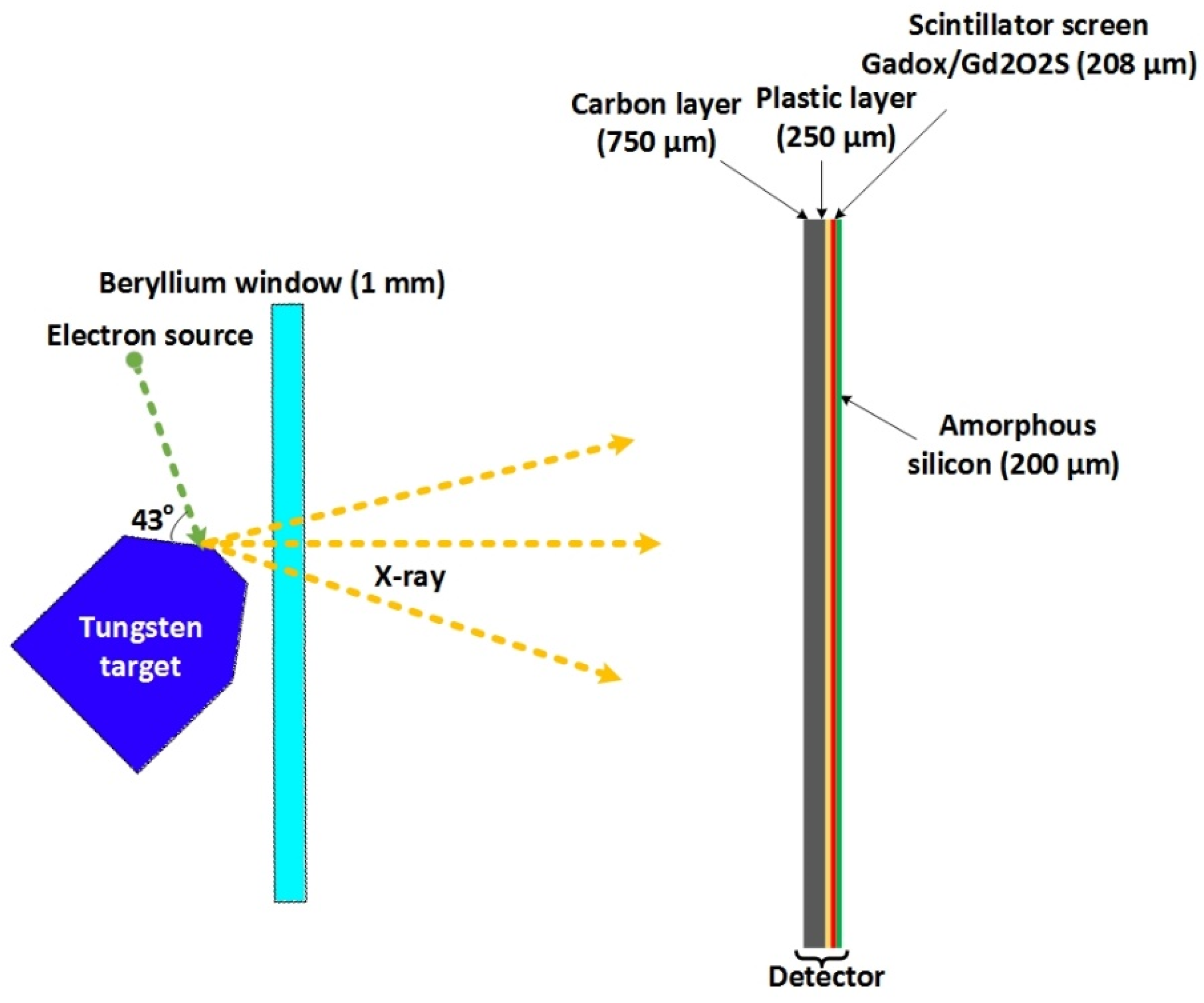

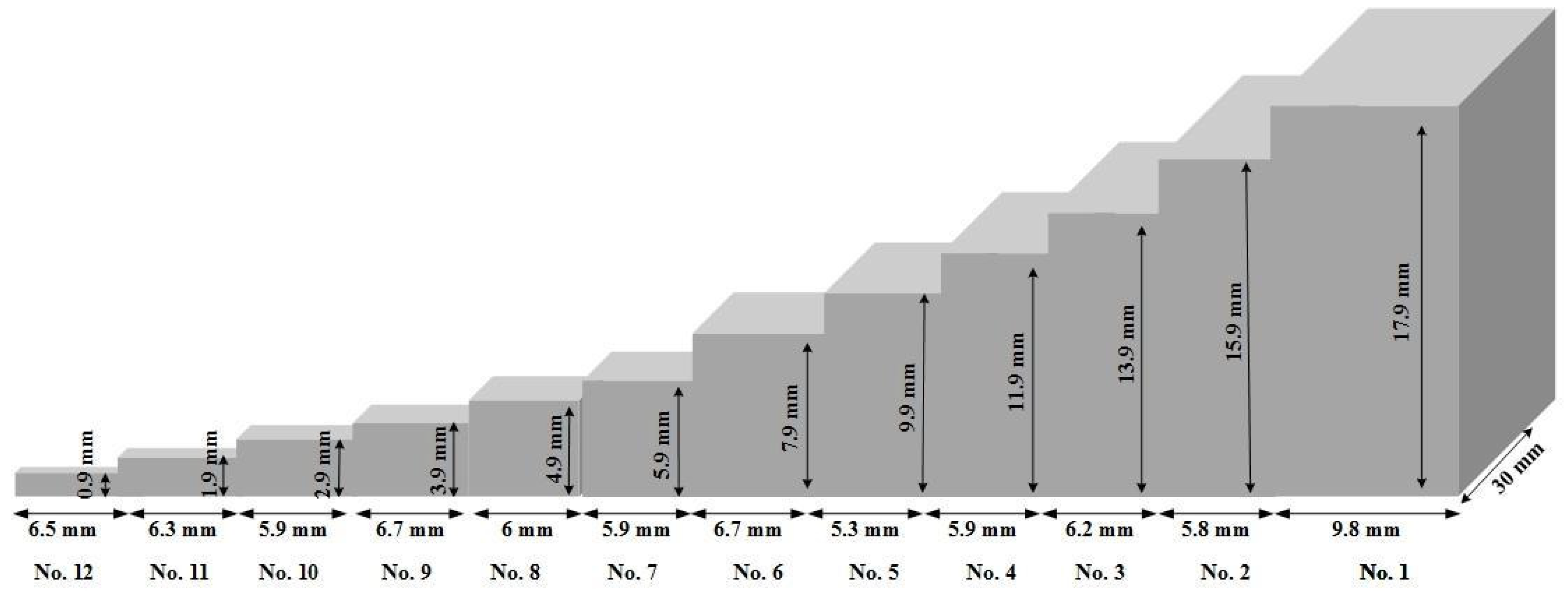
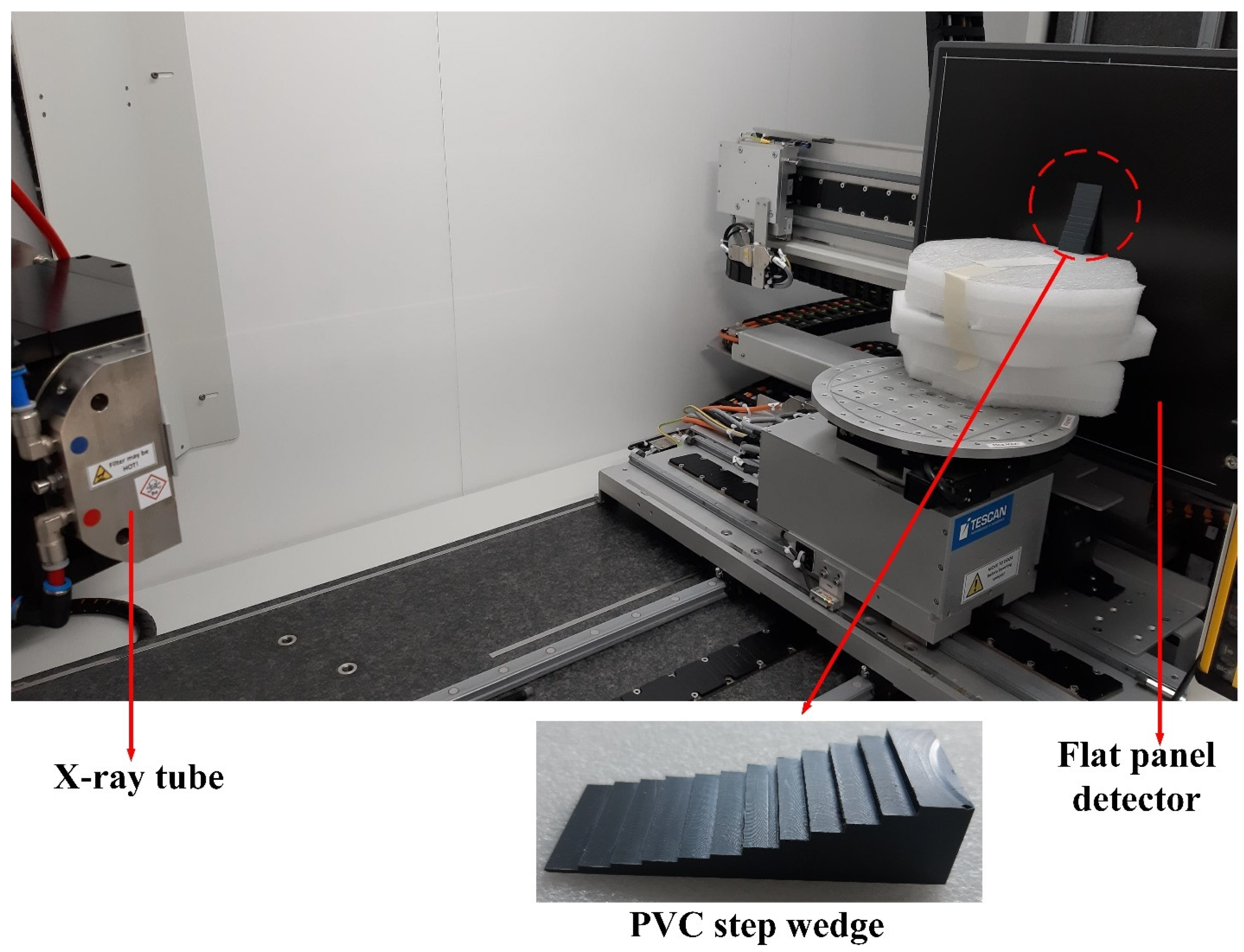
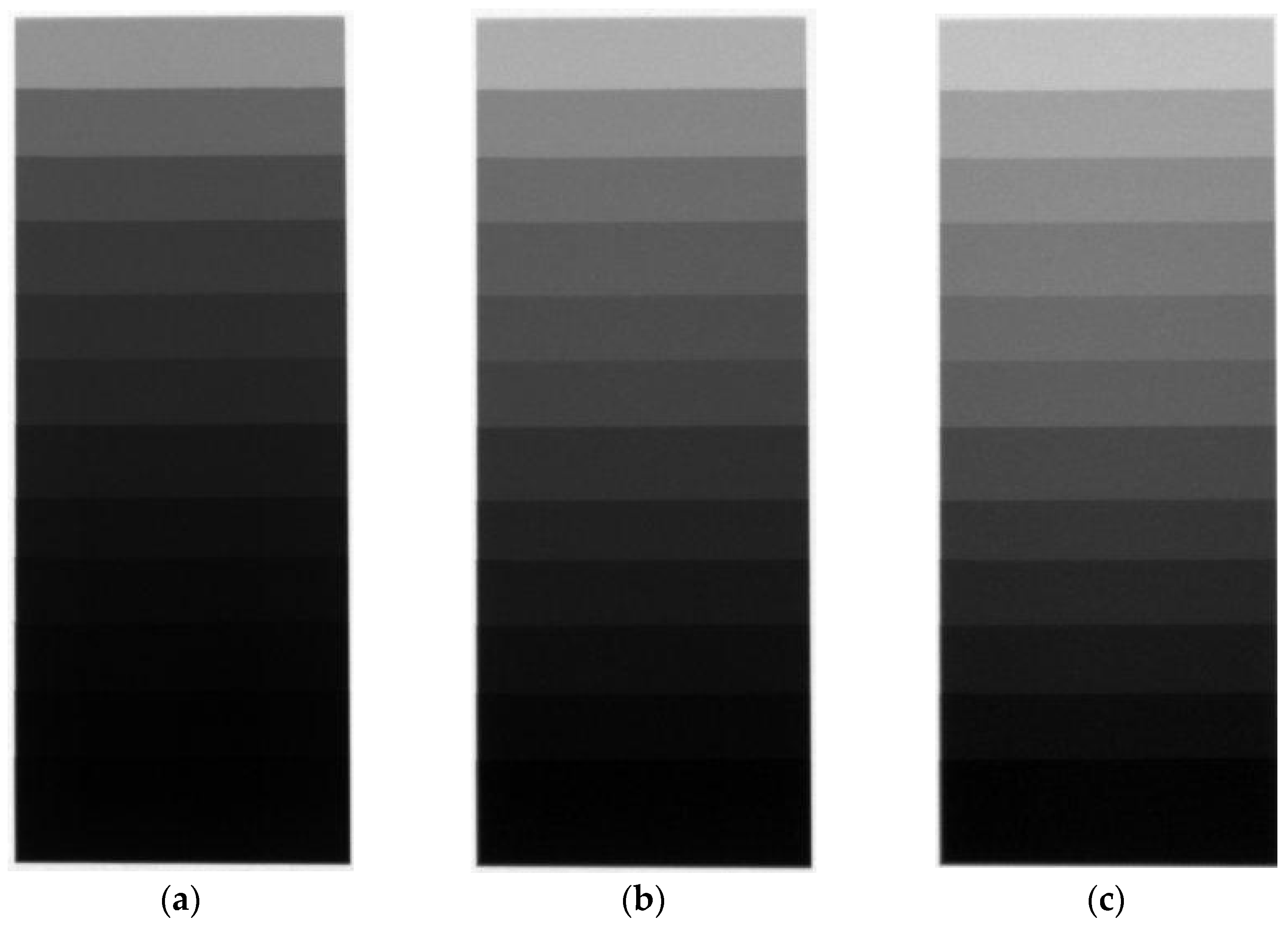
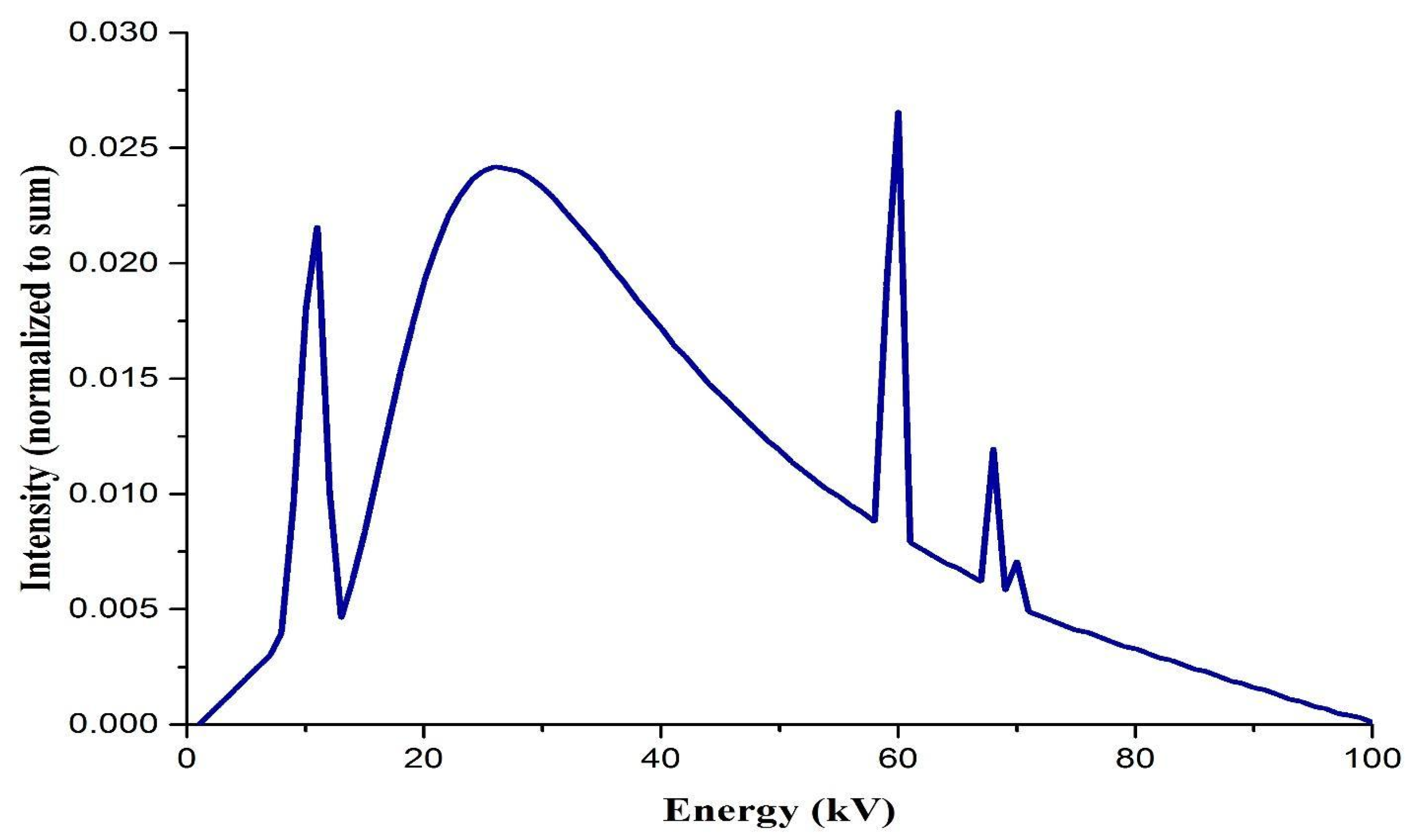
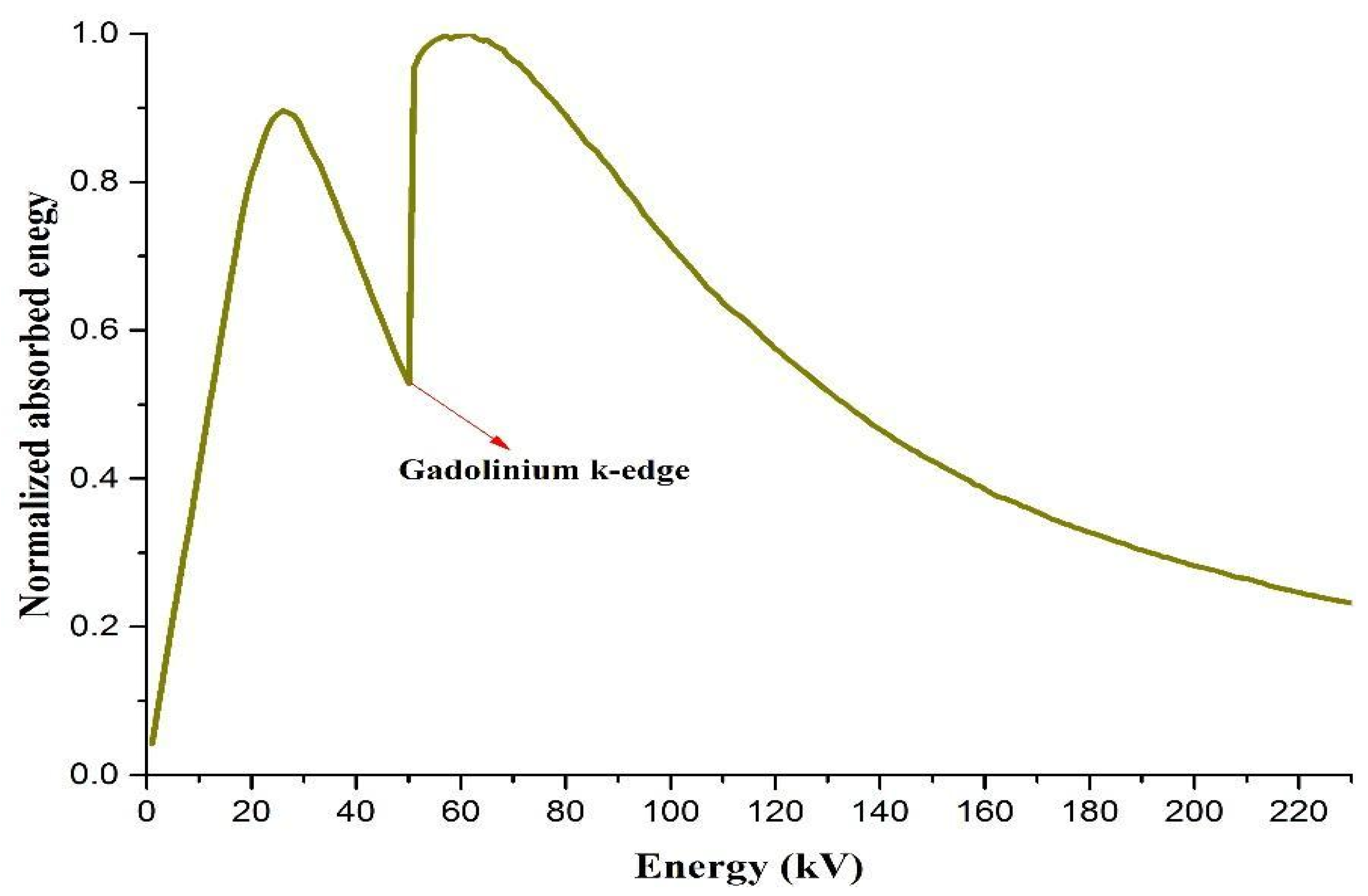

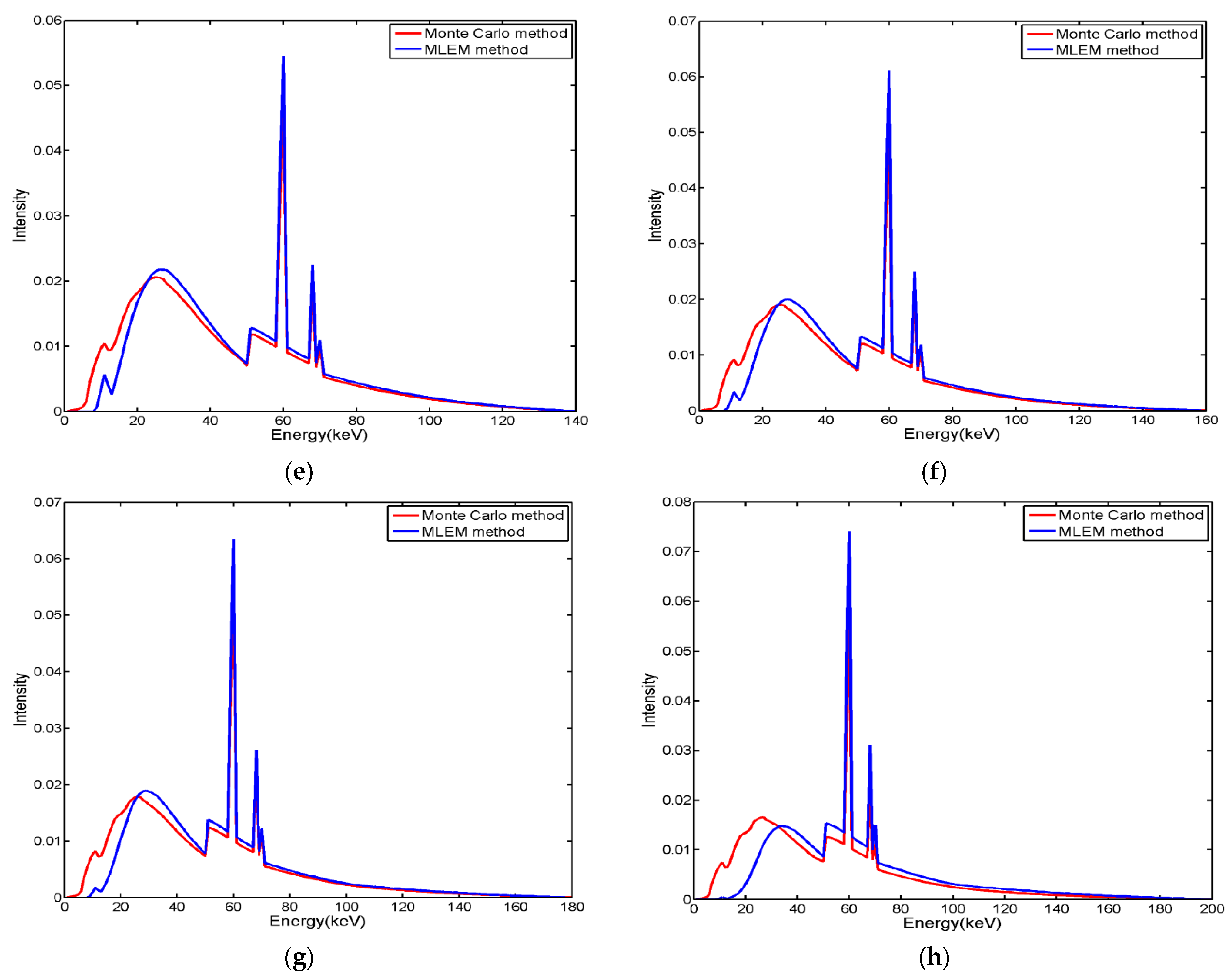
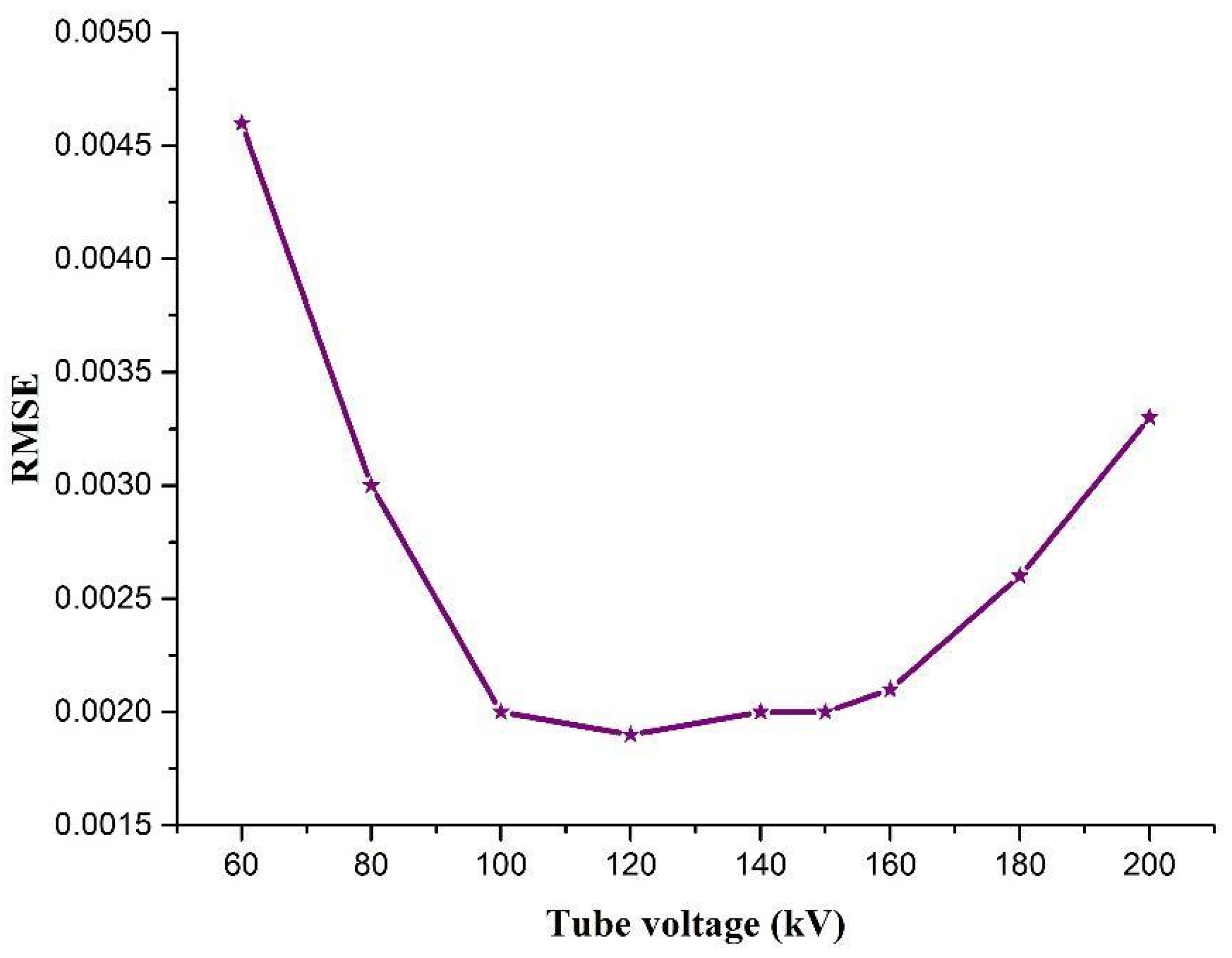
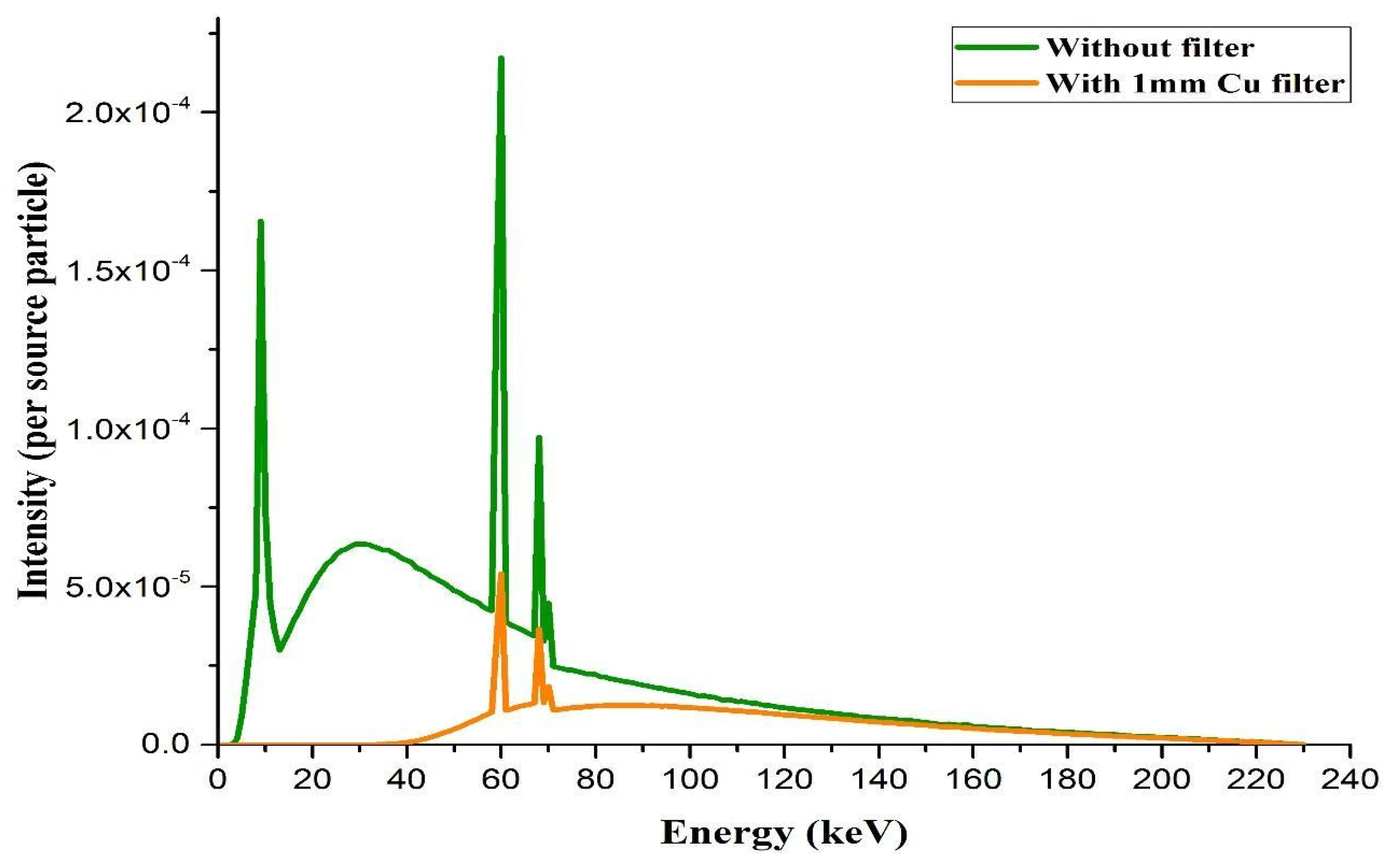
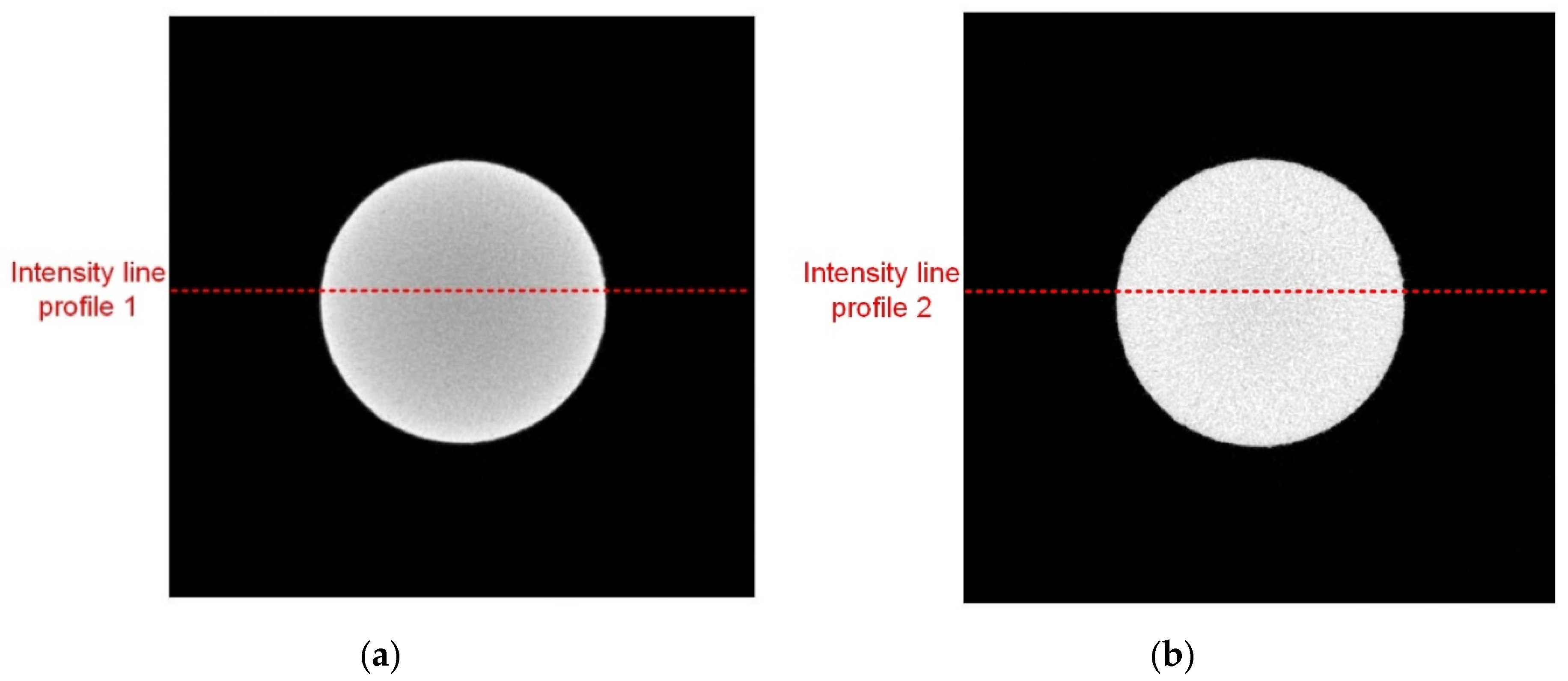
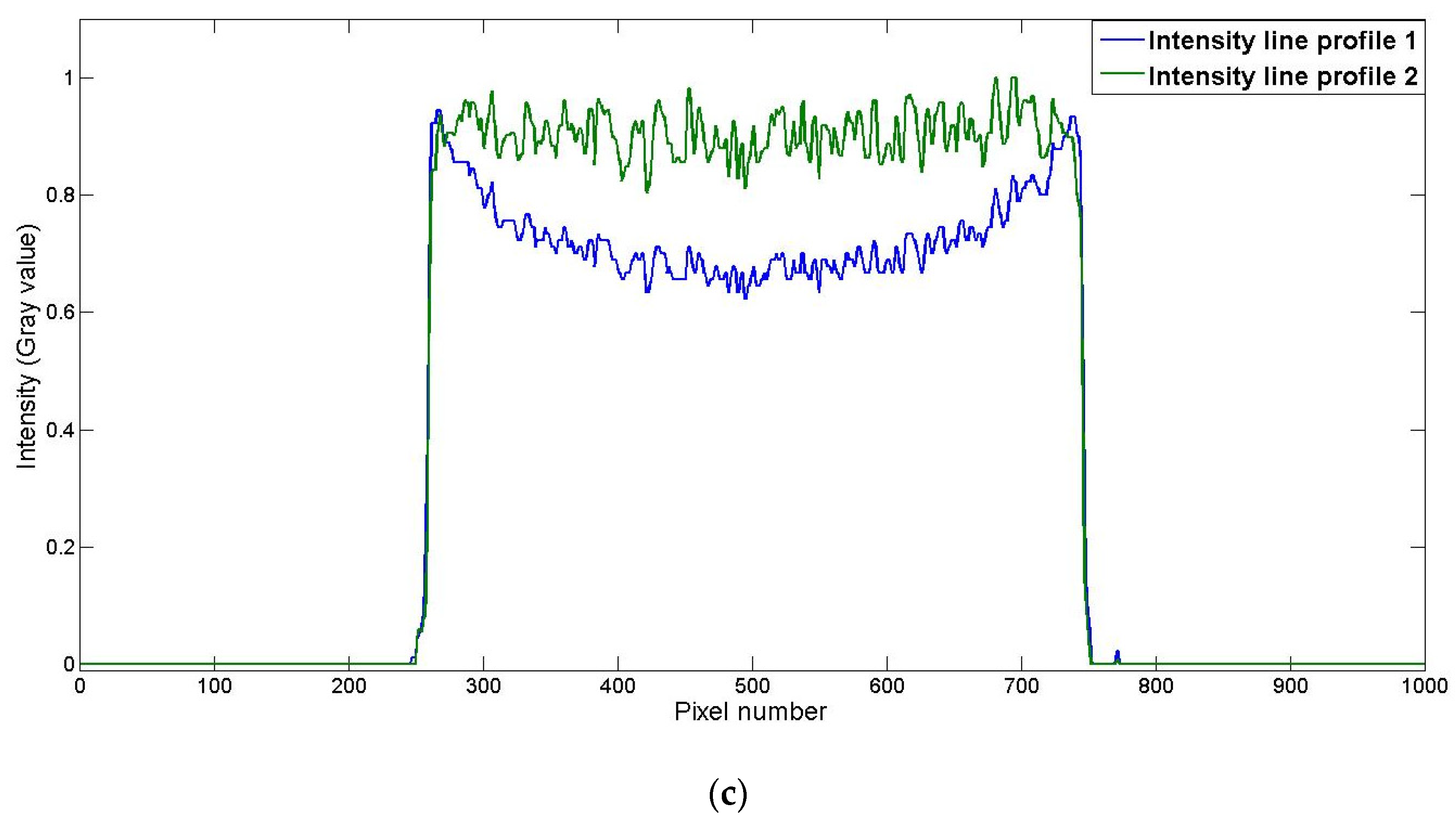
Publisher’s Note: MDPI stays neutral with regard to jurisdictional claims in published maps and institutional affiliations. |
© 2021 by the authors. Licensee MDPI, Basel, Switzerland. This article is an open access article distributed under the terms and conditions of the Creative Commons Attribution (CC BY) license (https://creativecommons.org/licenses/by/4.0/).
Share and Cite
Nazemi, E.; Six, N.; Iuso, D.; De Samber, B.; Sijbers, J.; De Beenhouwer, J. Monte-Carlo-Based Estimation of the X-ray Energy Spectrum for CT Artifact Reduction. Appl. Sci. 2021, 11, 3145. https://doi.org/10.3390/app11073145
Nazemi E, Six N, Iuso D, De Samber B, Sijbers J, De Beenhouwer J. Monte-Carlo-Based Estimation of the X-ray Energy Spectrum for CT Artifact Reduction. Applied Sciences. 2021; 11(7):3145. https://doi.org/10.3390/app11073145
Chicago/Turabian StyleNazemi, Ehsan, Nathanaël Six, Domenico Iuso, Björn De Samber, Jan Sijbers, and Jan De Beenhouwer. 2021. "Monte-Carlo-Based Estimation of the X-ray Energy Spectrum for CT Artifact Reduction" Applied Sciences 11, no. 7: 3145. https://doi.org/10.3390/app11073145
APA StyleNazemi, E., Six, N., Iuso, D., De Samber, B., Sijbers, J., & De Beenhouwer, J. (2021). Monte-Carlo-Based Estimation of the X-ray Energy Spectrum for CT Artifact Reduction. Applied Sciences, 11(7), 3145. https://doi.org/10.3390/app11073145







